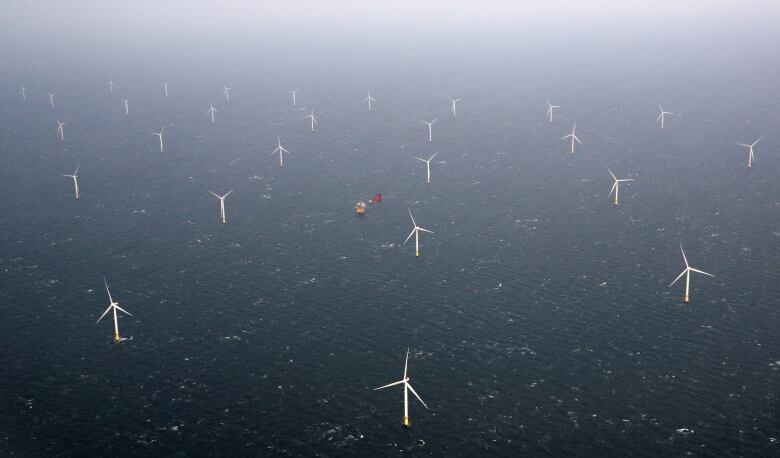The high cost of cheap electricity: Don Pittis
A glut of electric power means rock bottom wholesale prices that leave taxpayers on the hook

Producing electricity has never been so cheap.
Efficient generation technology, including low-cost wind and solar,and natural gas prices at levelsno one predicted a decadeago have contributed to those bargain prices.
According to the rules of market economics, that should be a good thing.
But whether through theirelectricitybills or through taxes, Canadians have been left paying for an expensive legacy system of power generation that produces more energy than the economy can consume.
Stuck with old tech
While similar problems exist across the country, energy economist Adam Fremethsays it may be most pronounced in Ontario. He points to the example of natural gas plants that spend most of their time on standby.
"Some of thefacilities that we have fixed contracts with and have agreed to take their power under different schemesareonly being used a few hours a year," says Fremeth, a specialist in economics and public policy atWestern University's IveyBusiness School.

As described in a report by Fremeth and his colleagues, wholesale power prices have plunged well below the cost of production.
"But only those who import from Ontario are paying that price," says Pierre-OlivierPineau,anexpert in energy policy and markets at HEC Montreal business school. That leaves Ontarianssubsidizing the export price.
The cost of electricity paid by consumers is closer to what's called the global adjustment price, which includes all those long-term contracts for expensive power that can stretch out decades into the future. The final bill also includes charges such as transmission fees and taxes.
Crucial but costly
A secure source of electrical power is so crucial to a modern economy that government agencies must plan decades in advance to make sure the lights don't go out.
Electricalauthorities must have enough capacity to supply the system when demand is at its peak. And commercial generators won't invest unless they have a secure market for their output.
And after they make their deal, both sides are stuck with it, says Pineau, pointing to Hydro-Qubec's contract to buy power from Churchill Falls at a fifth of a cent per kilowatt hour. The deal, which runs to 2041, has rankledNewfoundland and Labradorsince shortly after it was signed in 1969.

In Ontario, themajority ofelectricity production is tied tocostly long-term deals with nuclear generators that provide a constant stream of low-carbon-emission power. Some of the costs are hidden.
As part of its plan to move away from polluting coal, the Ontario government made deals withwind and solar producers, offering long contracts at high prices to compensate for the expenseof introducing the new technology. But the intermittent nature of green power meansthere has to be another layer of generating capacity that can be turned off and on, leading to a system condemned to overcapacity and high cost.
Cost exceeds benefit
Similarly in Quebec, says Pineau, despite a glut of low-cost power, the province is continuing to construct the final stage of its La Romaine hydroelectric project, planned when natural gas prices, and thus electricity prices, were high. Now few experts expect the price of power will justify the outlay.
British Columbia'sSite C and Newfoundland and Labrador's Muskrat Falls projects are facing similar concerns.
Quebec has already shut down its single nuclear plant.
If governments and power regulators across the country are already being hit by the disruptive effect of low-cost electricity, the Pembina Institute's Sara Hastings-Simon says prices are likely to continue to fall.
In Alberta, where she works, the market isderegulated, meaning the utilities and their investors take the risk, not taxpayers.
"There are twoimportant moments," says Hastings-Simon, who has a doctorate in quantum physics from the University of Geneva and worked for years as a consultant for McKinsey beforetaking a 60 per cent pay cut to move to the environmental group.
"One is when you hit the price whererenewables like wind and solar are cheaper than building new gas or coal plants," she says. "The second important milestone is whennew renewables become cheaper than operating existing plants."
She says we'rereaching that second moment now.

Hastings-Simon,PineauandFremeth all said that adapting to the new low-cost energy regime will require a rethink of our current models for funding electricity.
While some people say the massive new Tesla battery now up and running in Australia is the solution,thethree expertspointed to a cheaper way of creating new capacity that doesn't require building anything instead depending on pricing mechanisms to force consumers and industrial users to avoid using power during periods of peak demand.
It's been tried in Ontario with little effect on usage, and consumers don't like it. But studies have shown that in order to change people's habits, peak power costs must be more like four times the cost of power during periodsof low demand.
Politically, it will be a hard sell.
- ANALYSIS|Record cheap electricity is transforming world energy markets as Canada struggles to keep up
It seems likely that as the economy continues to grow, electricity demand will grow with it, soaking up the supply glut.Even the longest contracts for the costliest power will begin to run out and can be replaced with cheaper alternatives.
But duringthat long transition, for Canadian taxpayers, adapting to low-cost power may be an expensive proposition.
Follow Don on Twitter @don_pittis
More analysis from Don Pittis












_(720p).jpg)


 OFFICIAL HD MUSIC VIDEO.jpg)
.jpg)



























































































